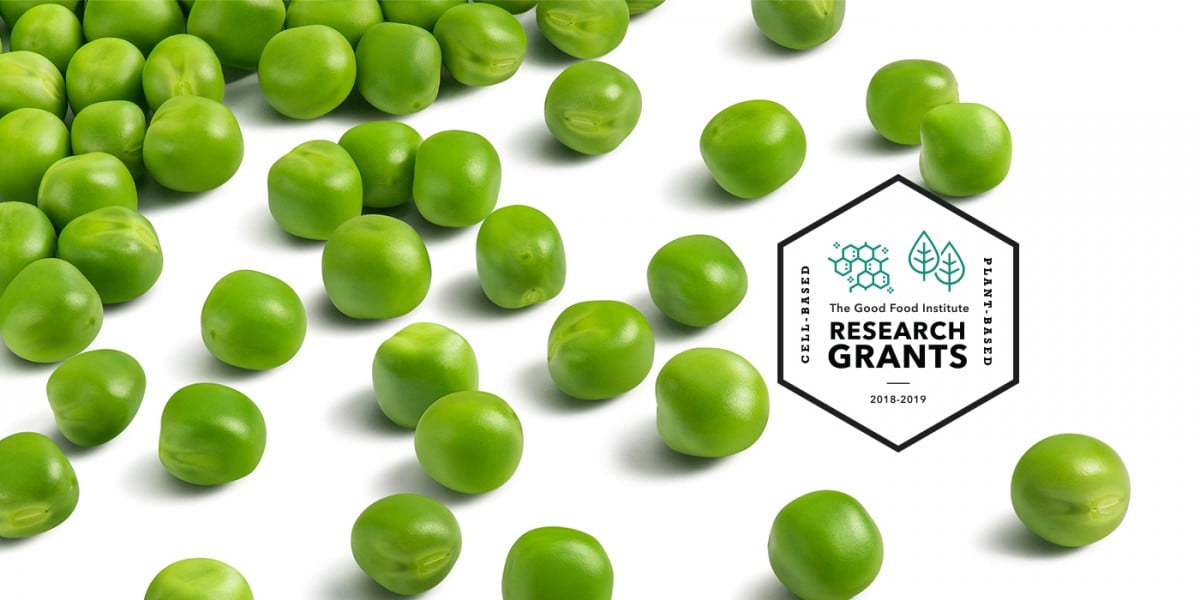Dr. Jian Li is taking the beany flavor out of plant proteins

Plant-based foods have a long history in China: soy milk was invented here in the 1300s and tofu over 2,000 years ago. In the new global wave of market enthusiasm for plant-based meat, China has an important role to play.
GFI research grant recipient Dr. Li is figuring out how to further optimize pea protein for plant-based meat. The goal is to remove the beany off-flavor in many pea products, setting a precedent for improving the flavor of other proteins as well.
Dr. Li is studying the structure of different pea varieties at the molecular level to gain a better understanding of how the compounds interact. He accomplishes all this by focusing on one key attribute: aroma.
How do you explain your research?
Consumers will not eat something if it does not taste good, even when they understand the health benefits. Flavor is one of the critical indicators for acceptance regardless of whether the consumer is nutritionally educated or not. It greatly influences their preference. We are trying to improve the flavor of pea bean proteins. When processing these proteins, unpleasant grassy and beany flavors usually occur. The off-flavors affect the taste and enjoyment of plant-based foods made from pea proteins. Identification of the off-flavor is the first step to remove it. Our research will provide a theoretical basis and ultimately make plant-based meat more delicious.
What sparked your interest to research plant-based meat?
Plant-based is the trend for the future of food. It is environmentally friendly and beneficial to our health. Plant-based meat has less saturated fats, trans fats, and cholesterol than animal meat.
Some issues in production are still unsolved, and flavor is one. Our lab is devoted to flavor analysis and has established several extraction methods. Our lab can isolate and identify the volatile compounds in proteins by using Gas Chromatography-Olfactometry-Mass Spectrometry, known as GC-O-MS. (This is basically a process of separating compounds by vaporizing them. The compounds are then analyzed by both a laboratory instrument and a human nose, to qualify odors. GC-O-MS is essential to this project as the goal is to isolate and compare flavors.)
Why is China an exciting place for plant-based research?
China has a long history of eating plant-based food. (Tofu was created in Han China over 2,000 years ago! It has been a staple in traditional Chinese food ever since.) Our country has extensive experience in manufacturing plant-based meat and people willing to try it. The population of China is around 1.3 billion people. This means the market is huge, especially since people are most likely already eating plant-based foods.
How many varieties of peas do you expect to research?
We will research four to five varieties in this experiment. The pea beans will come from Canada, which is the largest exporter of pulses (lentils, dry peas, and beans) in the world. We will work with Pulse Canada to investigate specific varieties of pea beans for our research.
What are you looking for when analyzing the flavor value of pea proteins?
We are looking to identify and quantify the aroma compounds of pea proteins. We also hope to determine the key off-flavor compounds through two processes: aroma analysis and calculating the activity of odor values.
Aroma experiments (recombination and omission) will test how off-flavor compounds influence the overall flavor. Both can assess how aromatic compounds contribute to a single substance. Still, these methods cannot explain how compounds enhance or inhibit the flavor in the complex matrix of a protein. There is too much interaction among compounds to draw any conclusions. We will need to perform flavor re-engineering experiments to confirm their influence on the overall flavor. Our analysis will show us if the compounds identified create unpleasant grassy and beany off-flavors. We also created a standard chemistry compound library.
How do you perform a flavor re-engineering experiment?
Flavor re-engineering is interesting research. We essentially combine the aroma compounds with a sample of deodorized pea protein. The protein sample is used as the matrix for recombining flavors. This allows us to analyze natural concentrations of the compounds. We use aroma compounds with odor activity values greater than or equal to 1, searching for any off-flavors. The odor attributes of the recombinant and original paste are evaluated by trained panelists (the human nose part of the equation!).
Does your research have the potential to create a new variety of pea without the beany off-flavor?
Yes! If you want to remove a flavor, you first must know what it is. After identifying the key off-flavor compounds in pea bean proteins, we will study the interaction between the compound and protein. We will determine if the bond is a hydrogen, ionic, or covalent one (molecular bonds influence flavor). Then we can remove the compound with physical or chemical methods, depending on the combination types. Finally, proteins without any off-flavor will be obtained. We have the ability to set standards for this process and detect which protein is better. The end goal is to create technology as a guide to make new protein without any off-flavors.
Check out all fourteen research projects here! For a deeper dive, GFI senior scientist Dr. Erin Rees Clayton contextualizes all fourteen plant-based and cell-based meat projects within current industry challenges.

